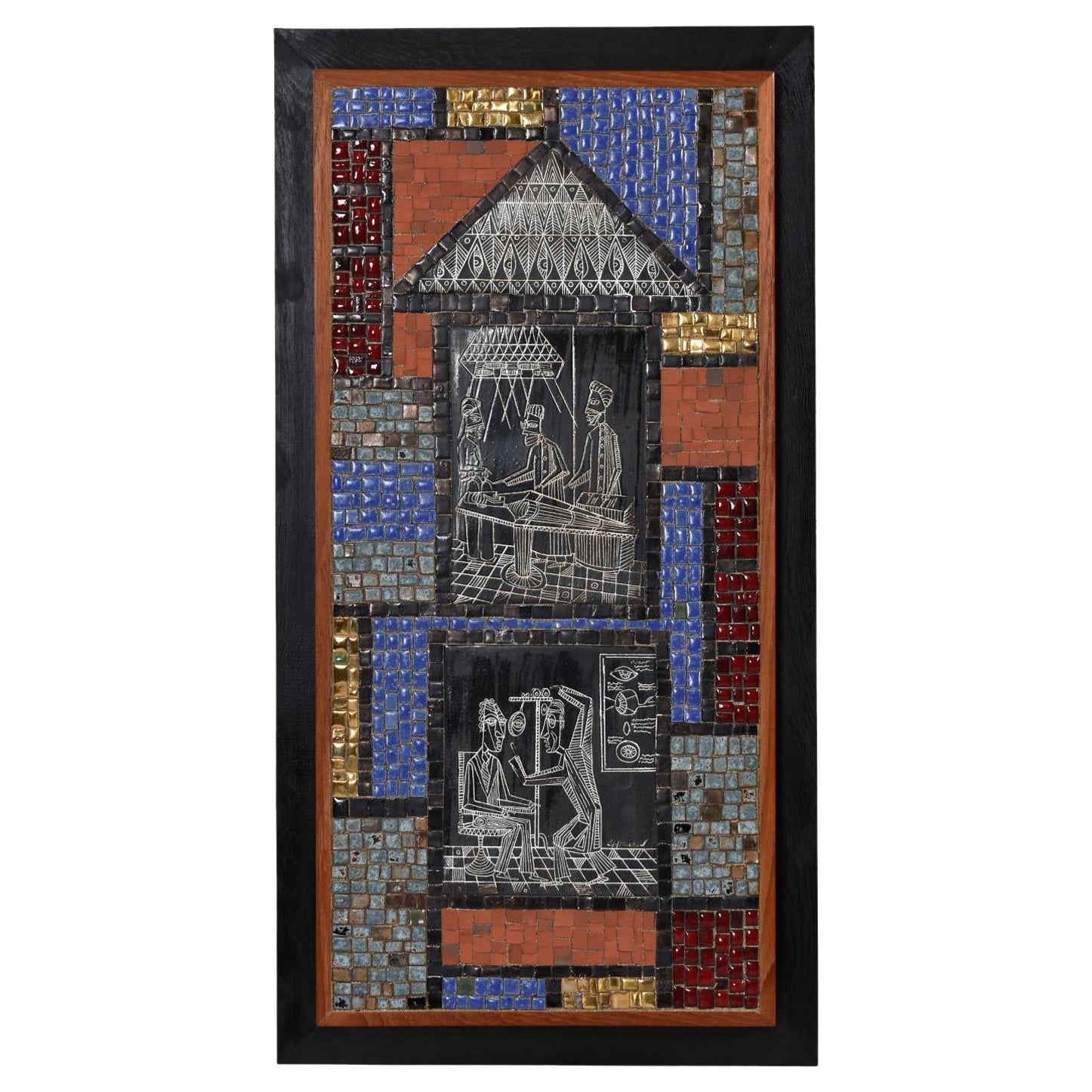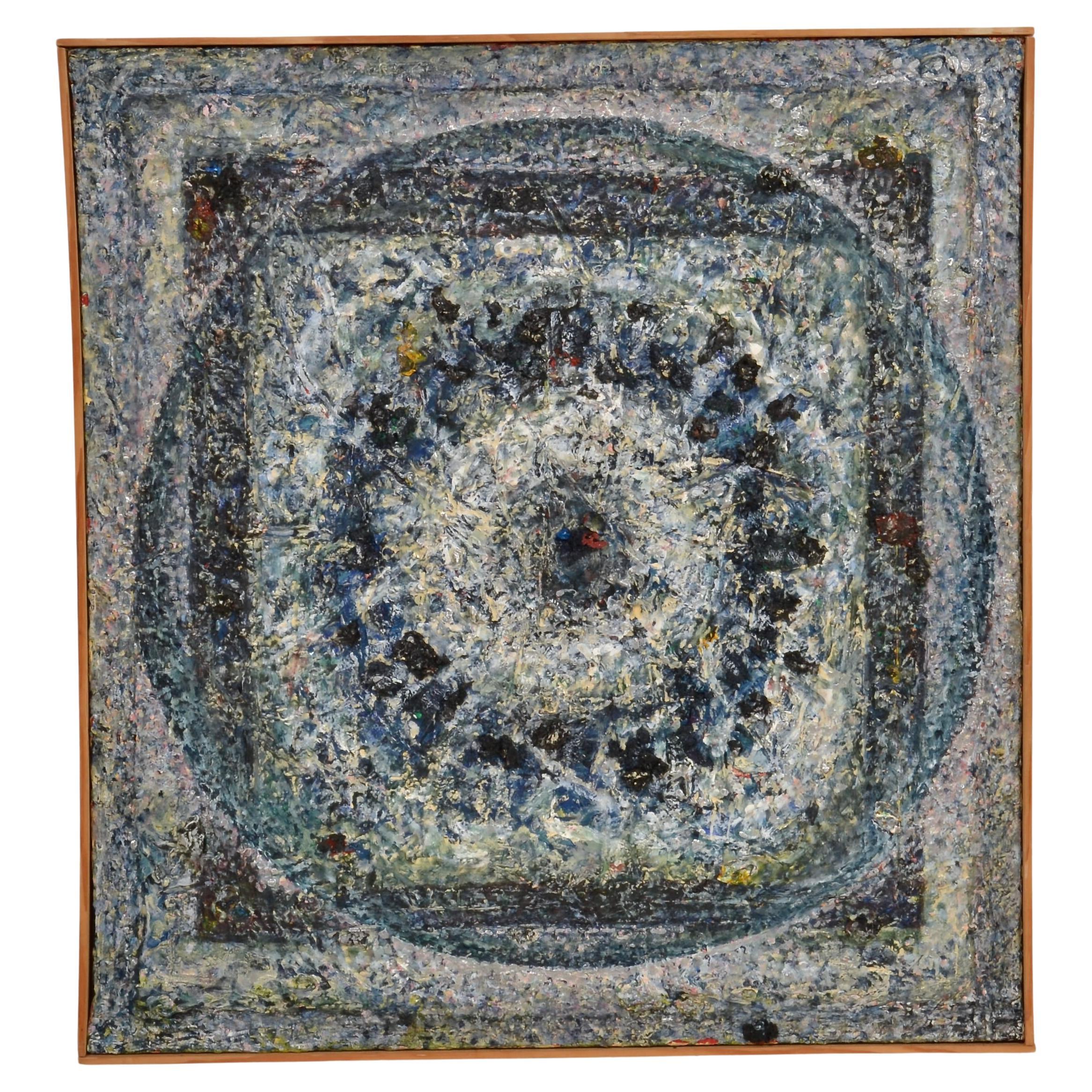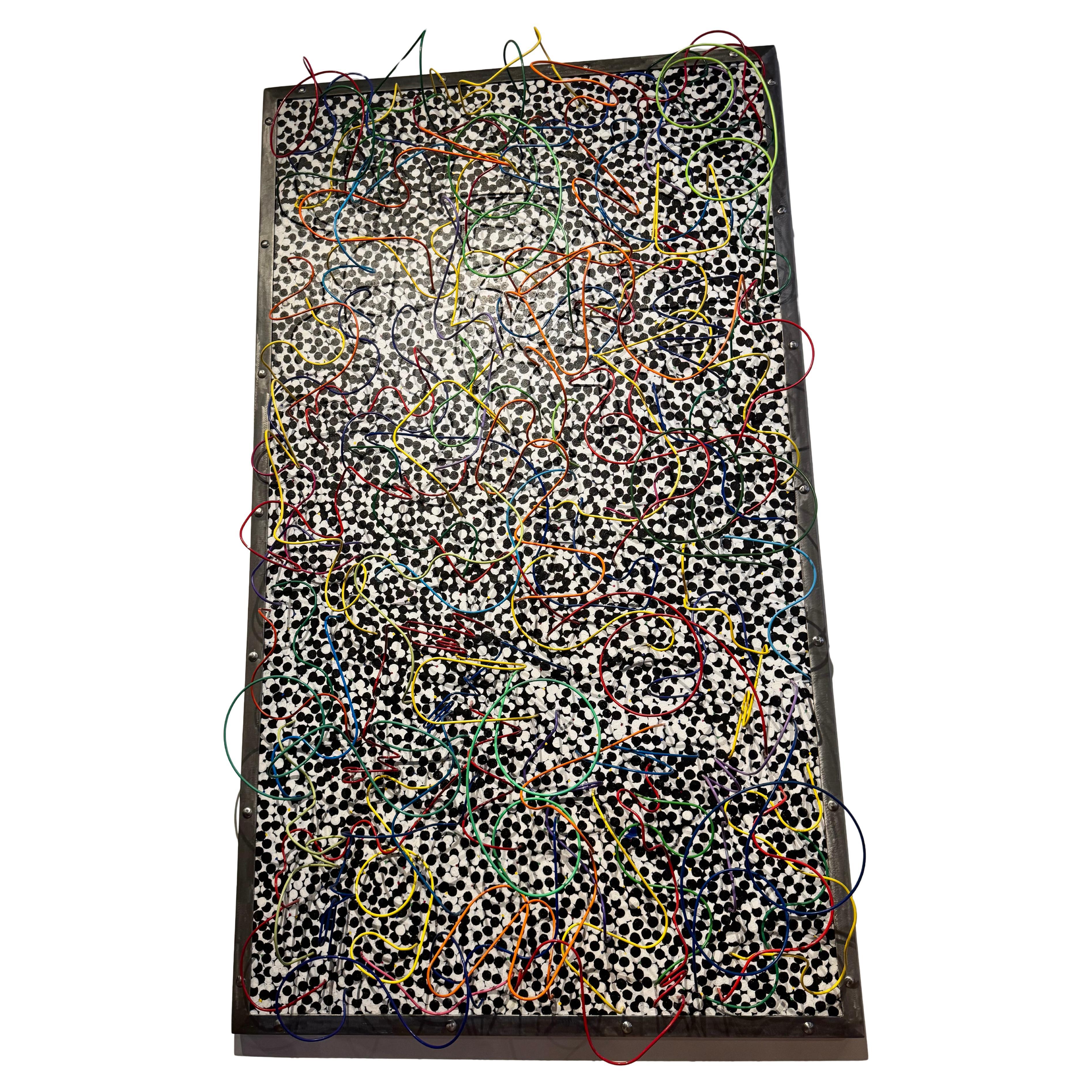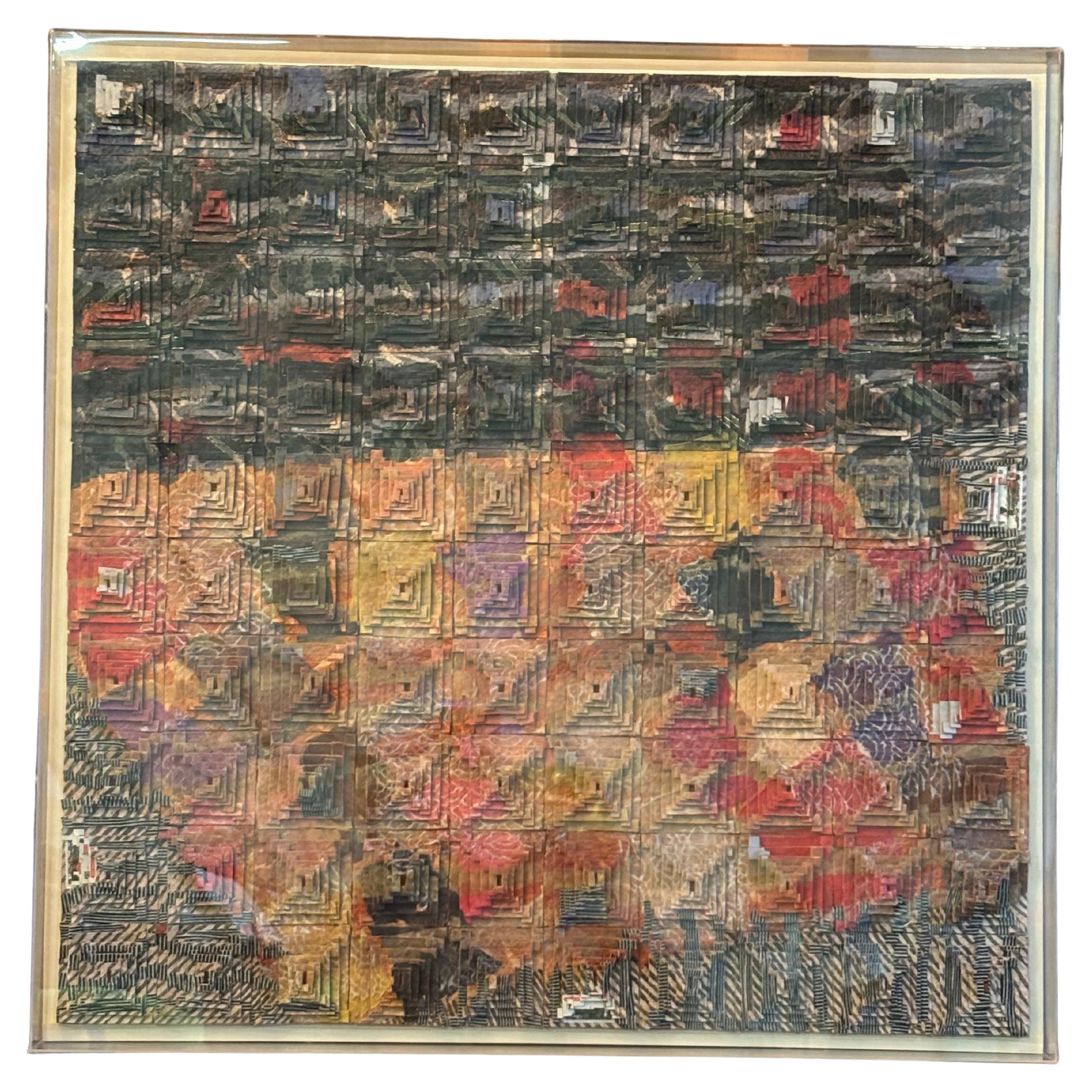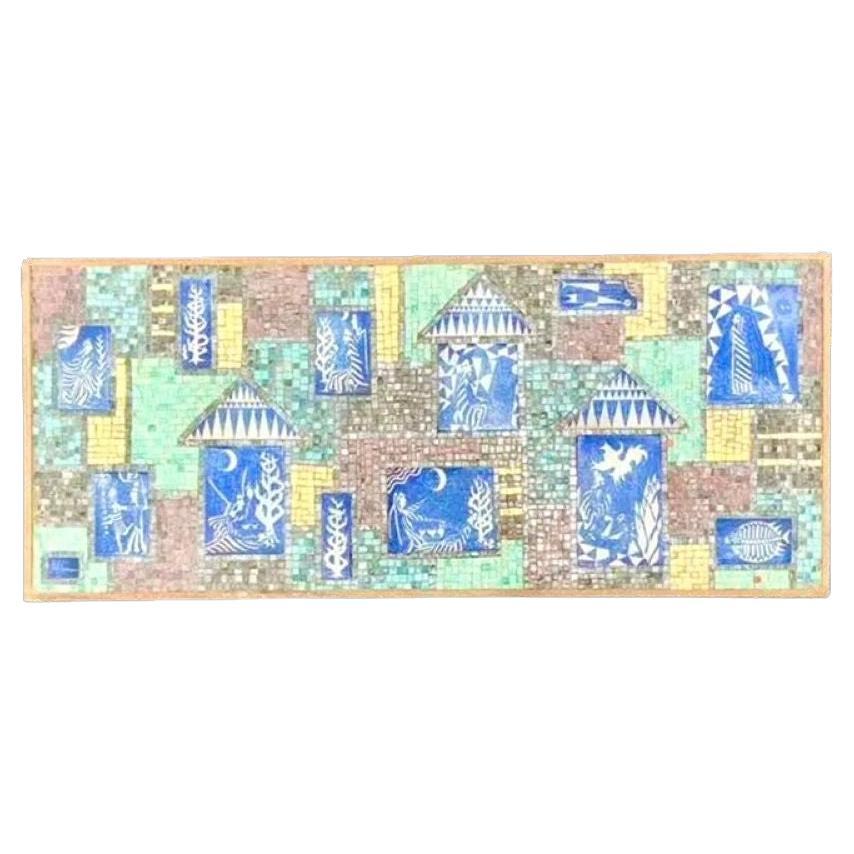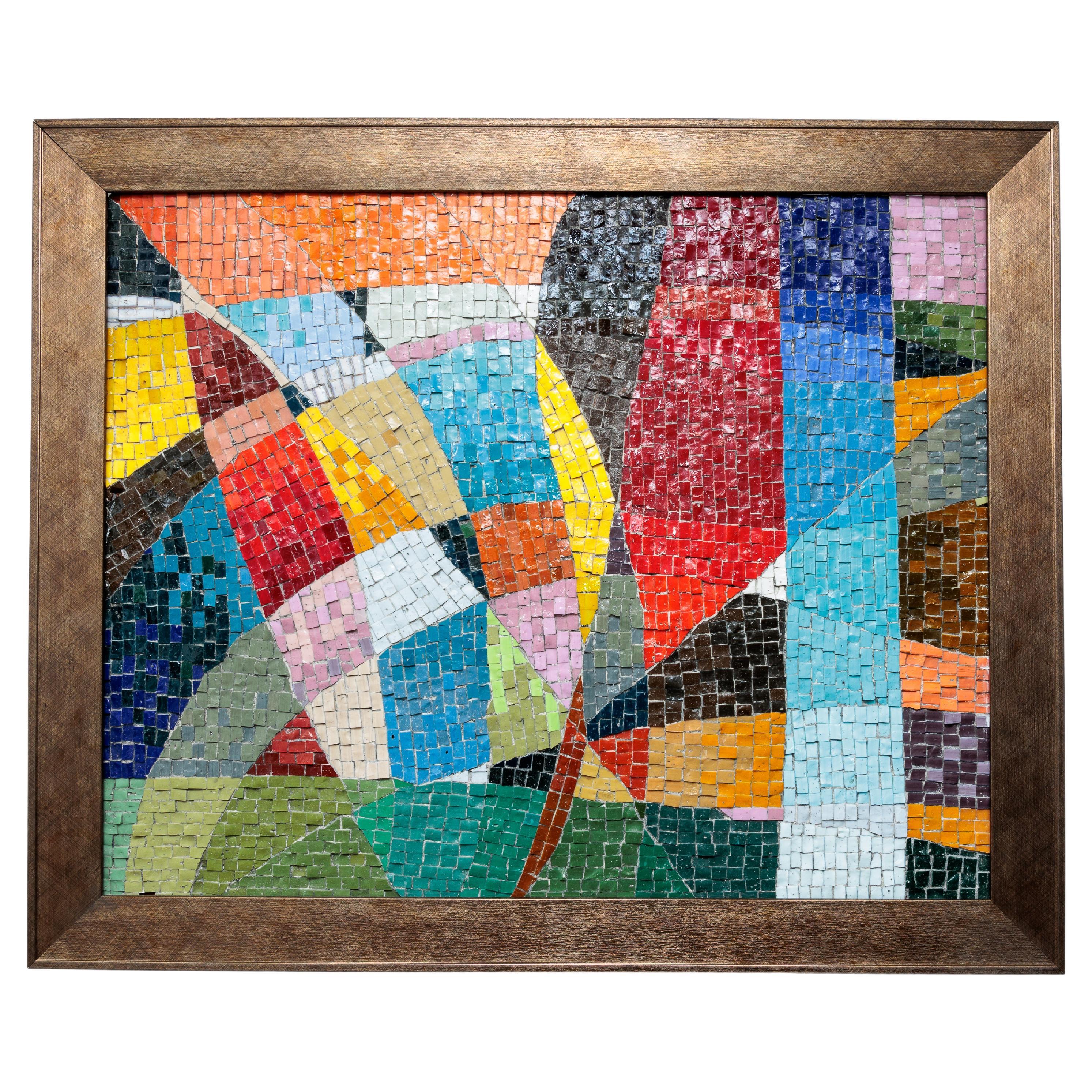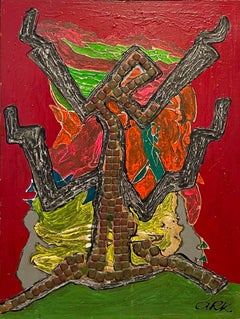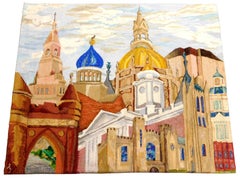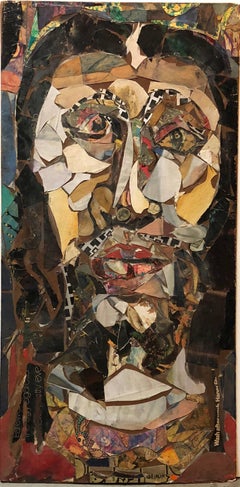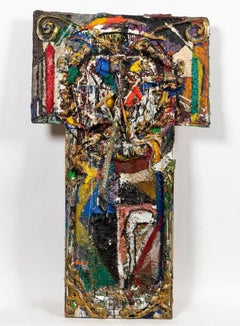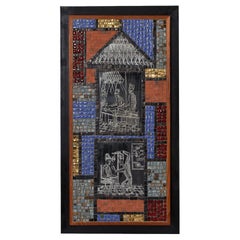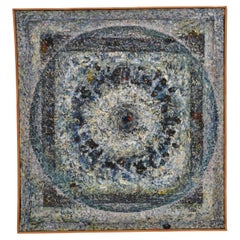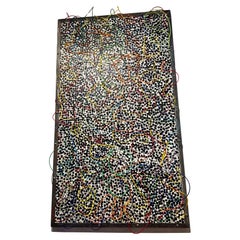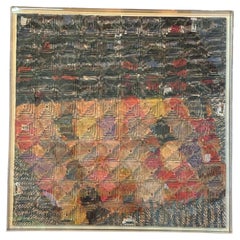Items Similar to Large American Folk Art Masterpiece Glass Mosaic Sculpture Painting Wall Hanging
Want more images or videos?
Request additional images or videos from the seller
1 of 19
Lawrence RothbortLarge American Folk Art Masterpiece Glass Mosaic Sculpture Painting Wall Hanging20th Century
20th Century
$10,000
£7,522.10
€8,670.48
CA$14,086.11
A$15,455.82
CHF 8,088.86
MX$190,208.73
NOK 101,907.44
SEK 95,451.50
DKK 64,741.52
About the Item
Titled: Pop (Samuel Rothbort) in our living room.
Bears estate stamp of his father, famed American folk artist Samuel Rothbort. one of only about 10 in total large scale mosaics that he did, each one took many months. very complicated intricate work made up of glass and tile in all different sizes and and shapes. This had been mounted as a coffee table top but was intended to be hung on the wall.
Lawrence Rothbort
1920-1963
Lawrence Rothbort, son of American Impressionist - Samuel Rothbort, was born in Brooklyn, N.Y. in 1920, and achieved fame for his expressionist style painting, earning comparison to Paul Gauguin and Vincent Van Gogh. At age 16 he dropped out of High School and became an avid reader of philosophy, religion and mysticism which, eventually, led him to become a moral vegetarian.
As a pacifist during World War II - he refused to serve in the military. A requirement therefore, was to work on farms due to the manpower shortage. For one year at the age of 24, he left home for the Pocono's where he would live as a hermit , living off the land and closely observing nature.
Rothbort returned home in 1945 determined to become an artist. As a self-trained artist, he worked non-stop, seven days a week, grinding his own paints, experimenting in oils, watercolors, pen & ink. He developed several new techniques such as the patient application of paint with sharpened twigs to the canvas, and the combination of oil painting with glass. He created enormous mosaics and it was not unusual for a piece to take several months to complete.
The Charles Barzansky Gallery gave him his first solo show in 1947. The reviews were excellent comparing his pen & ink drawing and painting to the "old masters" "extraordinary" and his oils "outstanding", "admirably executed", " a Seurat painter", "most personal revelation of an arresting talent" where he was praised by critics as a descendent of Paul Gauguin.
Like his father, he recorded the ever changing landscape of New York, including 5th Avenue with flags - always on location and never touching up or finishing an outdoor work in the studio. He stated their "Direct Art was synonymous with truth."
He worked in oil, casein, pen & ink and ceramic and glass. Depending upon the subject and medium, his work would take anywhere from 3 months to one and a half years; working every day for no less that 8 - 12 hours. In 1954, using discarded glass from the shores and junk piles, he embarked on a new phase in his career and began creating mosaics.
In 1956, he married a young piano teacher with whom he had three children. In 1956 they moved to Florida where he completed three major works, one of which was an enormous mosaic of his wife nursing their first born surrounded by everything they owned. The work is reminiscent of Medieval Madonna's.
Rothbort returned to Brooklyn in 1960 and established a small gallery behind his family's apartment. He would often travel with his supplies in a carriage to various locations throughout Manhattan, the Bronx, and Brooklyn painting from location, never touching up or finishing his outdoor work in a studio. He felt it was extremely important to be in direct contact with the subject being painted in order to convey its true feeling. He referred to this as " Direct Art ". He was a true Outsider Art artist.
His work can be categorized as visionary art or folk art but it really defies categorization.
In 1963, in an attempted robbery at his gallery. Rothbort was shot to death, leaving behind a pregnant wife and two children. His death sparked a memorial exhibit a few months later at the Riverside Gallery, where he received many outstanding newspaper reviews praising his work. A writer for the New York Post stated - " If some of the gallery visitors came looking for the birth of an American Van Gogh, not all of them go away disappointed ".
Lawrence Rothbort did not typically sign his work, as he always claimed his work was to original to have been done by anyone else.
- Creator:Lawrence Rothbort (1920-1963, American)
- Creation Year:20th Century
- Dimensions:Height: 48.25 in (122.56 cm)Width: 64 in (162.56 cm)Depth: 4 in (10.16 cm)
- Medium:
- Movement & Style:
- Period:
- Condition:frame with minor wear.
- Gallery Location:Surfside, FL
- Reference Number:1stDibs: LU38213857422
About the Seller
4.9
Platinum Seller
Premium sellers with a 4.7+ rating and 24-hour response times
Established in 1995
1stDibs seller since 2014
1,803 sales on 1stDibs
Typical response time: <1 hour
- ShippingRetrieving quote...Shipping from: Surfside, FL
- Return Policy
Authenticity Guarantee
In the unlikely event there’s an issue with an item’s authenticity, contact us within 1 year for a full refund. DetailsMoney-Back Guarantee
If your item is not as described, is damaged in transit, or does not arrive, contact us within 7 days for a full refund. Details24-Hour Cancellation
You have a 24-hour grace period in which to reconsider your purchase, with no questions asked.Vetted Professional Sellers
Our world-class sellers must adhere to strict standards for service and quality, maintaining the integrity of our listings.Price-Match Guarantee
If you find that a seller listed the same item for a lower price elsewhere, we’ll match it.Trusted Global Delivery
Our best-in-class carrier network provides specialized shipping options worldwide, including custom delivery.More From This Seller
View AllChicago Jewish Modernist Mixed Media Surrealist Painting WPA Artist Mosaic Tiles
By Alexander Raymond Katz
Located in Surfside, FL
Alexander Raymond Katz (Hungarian-American, 1895-1974)
initialed l.r. "A.R.K."
inscribed verso "Prayer Tree", A Raymond Katz."
Sight size: 39-3/4"h x 30"...
Category
Mid-20th Century Modern Abstract Paintings
Materials
Mixed Media, Alkyd, Board
Large Americana Folk Art Pictorial Hooked Rug Wool Wall Hanging Tapestry
By Trudi Shippenberg
Located in Surfside, FL
"Downtown Hartford"
Hooked rug tapestry, various landmark buildings in Hartford, Connecticut, congregate within composition, including capital building, Colt building, Wadsworth Mus...
Category
20th Century Folk Art Mixed Media
Materials
Fabric, Wool
Large Assemblage Collage 2 Sided Painting Outsider Art
By Paul Shimon
Located in Surfside, FL
Born in New York, Paul Shimon (1919 - 2011) was both an accomplished artist and composer.
Considered by some to be an Early Outsider artist, Shimon studied at the Art Students Leag...
Category
Late 20th Century Abstract Figurative Drawings and Watercolors
Materials
Mixed Media
Mixed Media Neo Expressionist Collage Assemblage Painting Sculpture Art Brut
By Loren Munk
Located in Surfside, FL
LOREN MUNK
(american b. 1951)
MUNKEY BUSINESS
Signed and dated 'Munk 84' verso, mixed media construction with paint brushes, mirrored mosaic tile, gold leaf and oil paint
57 x 33 x 23 in. (144.8 x 83.8 x 58.4cm)
Provenance: Malcolm Forbes collection
The artist Loren Munk (born 1951) is primarily known for his YouTube nickname James Kalm as an uploader of videos about New York exhibitions, amongst others. He presents himself as a maker of contemporary paintings for several decades and of cubist paintings of urban imagery. Munk has received accolades for his drawings and mosaics. He differs from traditional mosaic artists by the manner in which he incorporates glass into his decorative paintings. His unique and innovative use of materials such as mirror, gold-leaf and glass mosaic affirmed him as a founding force of Kitsch Art and a leading member of New York Neo-Expressionism.
Munk's work debuted in SoHo in 1981 with a double show at J. Fields Gallery and Gabrielle Bryers. Since then, he has overseen an international career. In addition to exhibiting in Brazil, France, Germany and the United States, Munk has received national and overseas, public and private commissions. He is well represented in important collections throughout Europe, South and North America and the Middle East.
Most recently, Munk has been producing a series of paintings which tackle the subject of art itself through a historical and diagrammatic lens. Munk documents the New York art world in YouTube videos, using the name James Kalm.
Timeline:
1979 Attended Art Students League, New York
1973-75 Attended University of Maryland at Ramstein, Germany while in US Army
1969-72 Attended Idaho State University, Pocatello, Idaho
1951 Born, Salt Lake City, Utah
Select Group Exhibitions
2018 “Under Erasure” curated by Heather and Raphael Rubinstein at Pierogi Gallery New York
2016 "It Was Never Linear: Recent Painting" at the Sheldon Museum of Art Lincoln Neb. with: Robert Bordo, Dawn Clements...
Category
1980s Neo-Expressionist Mixed Media
Materials
Gold Leaf
Large Mixed Media Collage Painting Great Jewish Feminist Artist Miriam Schapiro
By Miriam Schapiro
Located in Surfside, FL
Miriam Schapiro,
"Curtain Call"
2002
Hand signed, dated and titled verso and signed and dated recto.
acrylic paint, digital images, glitter and textile fabric on canvas, tooling with gold leaf embossing around self edge of painting.
size: 60 x 50 in
Miriam Schapiro (or Mimi Schapiro) (November 15, 1923 – June 20, 2015) was a Canadian-born artist based in America. She was a painter, sculptor and printmaker. She was a pioneer of feminist art. She was also considered a leader of the Pattern and Decoration art movement. Schapiro's artwork blurs the line between fine art and craft. Her paintings contain craft elements because crafts and decoration is associated with women and femininity. She used icons that are associated with women such as hearts, floral decorations, geometric patterns and the color pink. In the 1970s she made a small woman's object, the fan, heroic by painting it six feet by twelve feet. This bears the influence of the Pattern and Decoration movement artists such as Brad Davis, Mary Grigoriadis, Joyce Kozloff, Robert Kushner, Kim MacConnel, Sonya Rapoport, Miriam Schapiro and Valerie Jaudon. Shapiro was born in Toronto, Ontario, Canada. Her father was an industrial design artist who fostered her desire to be an artist and served as her role model and mentor. Her mother was a stay at home mother who worked part-time during the depression.
As a teenager, Schapiro was taught by Victor d’Amico, her first modernist teacher at the Museum of Modern Art. In the evenings she joined WPA classes for adults to study drawing from the nude model. In 1943, Schapiro entered Hunter College in New York City, but eventually transferred to the University of Iowa. At the University of Iowa, Schapiro studied painting with Stuart Edie and James Lechay. She studied printmaking under Mauricio Lasansky and was his personal assistant, which then led her to help form the Iowa Print Group. Lasanky taught his students to use several different printing techniques in their work and to study the masters' work in order to find solutions to technical problems.
At the State University of Iowa she met the artist Paul Brach, whom she married in 1946.. By 1951 they moved to New York City and befriended many of the Abstract expressionist artists of the New York School, including Joan Mitchell, Larry Rivers, Knox Martin and Michael Goldberg.
Schapiro worked in the style of Abstract expressionism during this time period. Shapiro and Brach lived in New York City during the 1950s and 1960s. During this period Shapiro had a successful career as an abstract expressionist painter in the hard-edge style. In December 1957, André Emmerich selected one of her paintings for the opening of his gallery. Schapiro not only honored the craft tradition in women's art, but also paid homage to women artists of the past. In the early 1970s she made paintings and collages which included photo reproductions of Mary Cassatt's and Georgia O'keefe's paintings. Early in her career, Schapiro started looking for maternal symbols to unify her own roles as a woman. Her series, Shrines (1963), was her first artistically successful attempt at compartmentalizing her life roles. Her painting, Big Ox No. 1, from 1968, references Shrines, however no longer compartmentalized. The center O takes on the symbol of the egg which exists as the window into the maternal structure with outstretched limbs. Her series, Shrines was created in 1961–63. It is one of her earliest group of work that was also an autobiography. Each section of the work show an aspect of being a woman artist. They are also symbolic of her body and soul.
In 1964 Schapiro and her husband Paul both worked at the Tamarind Lithography Workshop. One of Schapiro's biggest turning points in her art career was working at the workshop and experimenting with Josef Albers' Color-Aid paper, where she began making several new shrines and created her first collages.
In the 1970s, Schapiro and Brach moved to California so that both could teach in the art department at the University of California. Subsequently, she was able to establish the Feminist Art Program at the California Institute of the Arts, in Valencia with Judy Chicago. The program set out to address the problems in the arts from an institutional position. They wanted the creation of art to be less of a private, introspective adventure and more of a public process through consciousness raising sessions, personal confessions and technical training. She participated in the Womanhouse exhibition in 1972. Schapiro's smaller piece within Womanhouse, called "Dollhouse", was constructed using various scrap pieces to create all the furniture and accessories in the house. Each room signified a particular role a woman plays in society and depicted the conflicts between them. Along with Nancy Spero, Joan Snyder, Joyce Kozloff, Audrey Flack and Judy Chicago, she is from that first generation of Jewish American feminist women artists and includes Judaica in her work.
Schapiro's work from the 1970s onwards consists primarily of collages assembled from fabrics, which she called "femmages". As Schapiro traveled the United States giving lectures, she would ask the women she met for a souvenir. These souvenirs would be used in her collage like paintings. Her 1977-1978 essay Waste Not Want Not: An Inquiry into What Women Saved and Assembled - FEMMAGE (written with Melissa Meyer) describes femmage as the activities of collage, assemblage, découpage and photomontage practised by women using "traditional women's techniques - sewing, piercing, hooking, cutting, appliquéing, cooking and the like..."
She was involved in Abstract expressionism, Minimalism, Computer art, and Feminist art. She worked with collage, printmaking, painting, femmage [fr] – using women's craft in her artwork, and sculpture. Schapiro not only honored the craft tradition in women's art, but also paid homage to women artists of the past. In the early 1970s she made paintings and collages which included photo reproductions of past artists such as Mary Cassatt. In the mid 1980s she painted portraits of Frida Kahlo on top of her old self-portrait paintings. In the 1990s Schapiro began to include women of the Russian Avant Garde in her work. The Russian Avant Garde was an important moment in Modern Art history for Schapiro to reflect on because women were seen as equals.
Schapiro also did collaborative art projects, like her series of etchings Anonymous was a Woman from 1977. She was able to produce the series with a group of nine women studio-art graduates from the University of Oregon. Each print is an impression made from an untransformed doily that was placed in soft ground on a zinc plate, then etched and printed.
Her image is included in the iconic 1972 poster Some Living American Women Artists by Mary Beth Edelson...
Category
Early 2000s Contemporary Mixed Media
Materials
Glitter, Mixed Media, Fabric, Acrylic, Digital
French Outsider Art Brut Mixed Media Zinc Assemblage Sculpture Collage Painting
Located in Surfside, FL
Mixed media assemblage sculpture/painting. Hand signed and dated recto and verso.
Provenance: Galerie Alphonse Chave, bears their label verso
Michel, Fernand (1913-1999)
Born in 1913 in Neuviller-lès-Badonviller in the Vosges, Fernand Michel began working at the age of twelve in a Landes pottery factory. When his mother died, he went to live in Alsace with an aunt and became an art bookbinder. A lover of poetry, he bonded with Jean Vodaine, Jean Dubuffet and Alphonse Chave (Alphonse Chave was an art lover, dealer and collector. On November 15, 1947 in Vence, under the name Les Mages, he opened a contemporary art gallery which would also become a high place of art brut and unique art . The gallery took its final name - Galerie Alphonse Chave - in 1960. He exhibited Dado, Philippe Dereux, Jean Dubuffet, Max Ernst, Henri michaux, Louis Pons, Man Ray, Dorothea Tanning, Zao Wou-ki as well as other creators.)
Around 1962, he began carving zinc after finding a plaque in a landfill. From this period, he made numerous assemblies, most often of large dimensions, which he called "zinc works" where buxom bathers, Venus callipyges, nuns and holy nitouches rub shoulders. The corroded and battered material over the years, used as is, gives his works a certain harshness, however softened by more ornamental pieces. Fernand Michel lived in Montpellier. He died in 1999. His work is present in the collection of La Fabuloserie in Dicy.
Publications
Revue "Création Franche" N ° 16, November 1998
Catalog "Donation Claude Massé", March 1999
Catalog "Collection Création Franche - 1989-2010", September 2010
Revue "Création Franche" N ° 38, June 2013
Franche Creation, Special Issue N ° 2, April 2015
His son Patrick Michel's collection is housed in Montpellier in the Musee d’arts brut, singulier and autres. "I used to accompany my father to his exhibitions since he was exhibited every year at the Galerie Chave in Vence. I still remember that Alphonse Chave once offered me a little toy (a car!) from his shop. I therefore met the artists Philippe Dereux, Armand Avril, François Ozenda, Pascal Verbena, Louis Pons, Jean Vodaine, Henri Comby, Fred Deux and Eugène Gabritschevsky- I took the decision to create the museum in order to save (and protect) my father’s work- my father was often classified under the ‘Art Brut’ label but in fact he belonged to the ‘Singular Art’ label...
The term Art Brut exists since Jean Dubuffet gave it to us in 1945, covering self-taught and marginalised artists..The terms Outsider Art and Art Brut are fine with me- I place Nek Chand before Le Facteur Cheval. I also like the Art Brut artists Augustin Lesage...
Category
1960s Outsider Art Mixed Media
Materials
Metal
You May Also Like
David Holleman Mosaic Tile Art Panel with Sgraffito Illustratration
By David Holleman
Located in Chattanooga, TN
Mid-Century Modern era mosaic tile art panel by celebrated artist, David Holleman (1927-2020). Holleman is a prolific artist with a storied career spanning the better part of the 20th century and into the 21st. During his time serving with the US Army in Berlin, he became influenced by German Expressionist painter Carl Hofer. Once Holleman returned to the US he turned to ceramics as his primary medium. Despite winning national prizes for his pottery, he endeavored to further explore the medium. Holleman began working with his hallmark, mosaic tiles. Holleman produced over 50 mosaic tile murals...
Category
Mid-20th Century American Mid-Century Modern Decorative Art
Materials
Wood, Paint, Ceramic
Mixed Media on Canvas by S. Uebayashi, USA c 1983
Located in Norwalk, CT
This work features very heavy impasto in a range of blues and whites with specs of color in a geometric design of circles and squares formed by the application of heavy medium. Frame...
Category
Vintage 1980s American Modern Paintings
Materials
Paint
Large Abstract Sculpture / Painting / Wall Hanging by W.N.Y. Artist John Tracey
By John Tracy
Located in Buffalo, NY
Large Abstract Modernist Three Dimensional Wall Sculpture , hanging / Painting,,,
John Tracey ,,,
1977-1979 Artist in Residence, Artpark Lewiston NY. Invited for three consecutive...
Category
2010s American Folk Art Paintings
Materials
Metal, Steel
Framed Lucite Collage
Located in Philadelphia, PA
Collage made up of different papers and fabrics, stamps and a few other odd materials. Signed and dated to backside. In very nice Lucite Box.
Category
1990s American Modern Contemporary Art
Materials
Paper
Vintage Mid-Century Modern Mosaic Tile Wall Sculpture
Located in West Palm Beach, FL
Add a touch of retro elegance to your space with the Vintage MCM Tile Mosaic Wall Hanging. This American-style Mid-Century Modern piece features intricate til...
Category
Mid-20th Century North American Mid-Century Modern Wall-mounted Sculptures
Materials
Stone
Framed Mosaic Wall Art
Located in Bridgehampton, NY
Very colorful handmade mosaic framed wall art.
Category
Mid-20th Century American Mid-Century Modern Decorative Art
Materials
Twig
$1,850
More Ways To Browse
Mosaic Art
Glass Large Wall Art
Large Scale Glass Art
Old Florida Art
Glass Mosaic Wall Art
Felt Wall Hanging
Junk Art
Large American Flag
Folk Art Train
Outdoor Wall Art Vintage
Hanging Ceramic Wall Art
Large Outdoor Wall Art
Mosaic Wall Art Mid Century
Outdoor Pop Art
Hanging Tile
Florida Folk Art
Folk Art Tiles
Midcentury Shot Glasses
